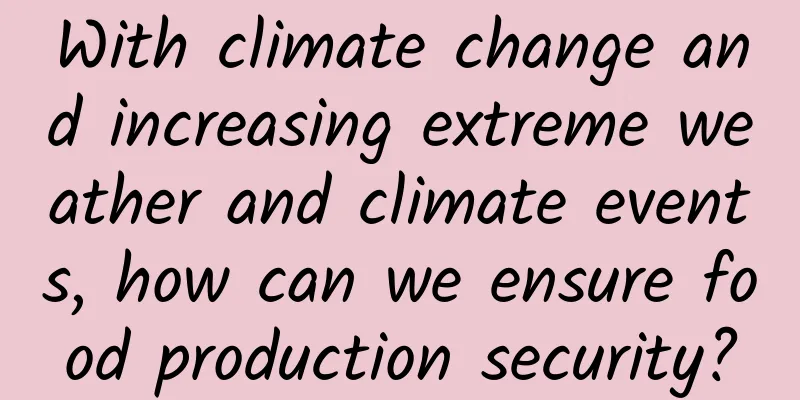With climate change and increasing extreme weather and climate events, how can we ensure food production security?

|
Produced by: Science Popularization China Author: Zhou Tianjun (Researcher and Deputy Director of the Institute of Atmospheric Physics, Chinese Academy of Sciences) Producer: China Science Expo Editor's note: In order to cultivate scientific thinking and encourage rational thinking, the China Science Popularization Frontier Science Project has launched a series of "Science Sharp Comments" articles, inviting academicians and other scientific research leaders to deeply analyze popular scientific and technological issues from a scientific and technological perspective. Let us ignite the spark of wisdom and explore the far-reaching impact of science and technology. Food is the primary need of the people. Food security is related to people's livelihood and the overall situation. However, with global warming, extreme weather and climate events have occurred frequently, bringing serious challenges to my country's food production. Against the background of increasing and intensifying extreme weather and climate events, how to ensure food production and food security has become a difficult problem that needs to be solved urgently. In the summer of 2023, sudden rainfall in Henan Province brought considerable challenges to local wheat production. Henan is the largest wheat production base in my country. Encountering this kind of continuous cloudy weather during the wheat harvest season will indeed cause great losses to wheat production. The main reason is "ear sprouting". The increase in soil moisture caused by rainfall has a certain impact on the root growth and respiration of wheat, and the wheat ears will sprout. It has two consequences. One is that it will affect the quality of wheat and its later storage. The other is that it will affect the sowing in the following year, which will ultimately cause relatively large economic losses to wheat production. Wheat ears from farmers in Fangcheng County, Nanyang, Henan Province, May 29, 2023 (Photo source: Beijing News reporter Zhao Lixin) In June 2024, Henan Province experienced a severe drought, and large tracts of farmland were difficult to cultivate. However, only one month later, torrential rains hit Henan Province, flooding the crops. The sudden change from drought to flood had a serious impact on food growth. Food security is an important part of national security and is related to the national economy, people's livelihood and social stability. What meteorological factors affect our food security, and how can we mitigate climate change and protect food security? How do water resources affect food security? The World Climate Research Programme has been established in the field of international climate change research. It has set seven major scientific challenges. All of these challenges involve the sustainable development of human society. Two of them are directly related to food production. One of them is the issue of water resources to maintain food security, because climate change can affect food security by changing water resources. The second is extreme weather and climate events. Our focus today is on "how extreme weather and climate events affect food production." Regarding the impact of climate change on water resources, we have many examples, such as the impact of drought on agriculture. The North China region where Beijing is located is actually facing a water shortage problem. The eastern part of my country is controlled by the monsoon climate. Since the late 1970s to the beginning of this century, the East Asian summer monsoon has been weakening, causing the precipitation in the eastern part of my country to show the characteristics of "floods in the south and droughts in the north". The drought-prone area happens to be in North China, and the wheat production in North China depends largely on agricultural irrigation. In order to maintain agricultural production, a certain amount of groundwater needs to be extracted. Excessive groundwater exploitation has formed a "hollow funnel" phenomenon in North China, which is actually an example of how water shortage affects agricultural production. In recent years, with the implementation of major water conservancy projects such as the South-to-North Water Diversion Project, the promotion of water-saving irrigation technology, and the recovery and strengthening of the summer monsoon, the hollow funnel phenomenon of groundwater in North China has been effectively controlled. Image source: CCTV.com Be prepared for danger in times of peace and pay attention to food security From a global perspective, many regions still have food shortages. Sometimes netizens may pay more attention to local issues, but from a larger global perspective, food security is still a topic that requires high attention. The World Economic Forum once released the Global Risk Report for 2023, which lists the top ten risks in the short and long term. The short term refers to the last two years, and the long term refers to the last ten years. There are two aspects of short-term risks. On the one hand, there is the rising cost of living, including the impact of the epidemic and the conflict between Russia and Ukraine, and on the other hand, there are extreme weather and climate events and natural disasters. Long-term risks such as natural resource crises within ten years will affect food security, so we still need to be aware of risks. Back to climate change itself, whether it is developed countries or developing countries, whether it is major grain-producing areas or other regions, we must face the problem of climate change together. Take temperature as an example. Since industrialization, global warming has been gradually increasing. According to the data statistics of the Sixth Assessment Report of the Intergovernmental Panel on Climate Change, the warming rate of the global average surface temperature from 2011 to 2020 is 1.09 degrees, while it was only 0.85 degrees from 1995 to 2014, and only 0.69 degrees from 1986 to 2005. It can be seen that from the past to the present, the warming rate of the global average temperature is getting faster and faster. Image source: veer gallery In addition, in terms of spatial distribution, the extent of warming is regionally uneven. In general, high-latitude regions warm faster than low-latitude regions, and land warms faster than oceans. With global temperature rise, extreme weather and climate events have increased significantly in many regions. Moreover, it is estimated that some major grain-producing areas, including North America, will face more extreme climate events, including extreme heat waves and extreme precipitation, in the future, which will have an impact on food production. In particular, spatially complex heat waves that occur in multiple parts of the world in the same growing season have a greater impact on global food security. Our recent research shows that the cumulative intensity of heat waves in the growing season in farmland areas around the world continues to increase with global warming, resulting in a continuous increase in heat wave exposure to gross primary productivity of vegetation. In the future, farmland areas in Asia, North America and Europe will be most exposed, which will directly affect food production. How can technology combat climate change? How can technology address the adverse effects of climate change? In the short term, we first need to improve the monitoring and forecasting of disastrous weather and climate events . This requires the use of numerical forecasting models based on high-performance computers, including the latest AI technology, to improve the ability to forecast extreme weather events in the next one to two weeks, so as to be prepared in the field of agricultural production. Image source: veer gallery In the long run, we need to actively take effective measures to adapt to and mitigate climate change. Under the United Nations Framework Convention on Climate Change , the international community proposed the Paris Agreement to address climate change, which includes two temperature control targets, that is, the world will work together to control the global temperature rise within 2 degrees relative to the pre-industrial level by the end of this century, and strive to achieve 1.5 degrees. This is what we usually call the 1.5-degree and 2-degree temperature control targets. To achieve this goal, it is necessary to reduce anthropogenic carbon emissions. In this regard, my country's "dual carbon target", namely "striving to peak carbon dioxide emissions before 2030 and strive to achieve carbon neutrality before 2060", is actually a specific measure to implement the Paris Agreement of the United Nations Framework Convention on Climate Change. In addition, my country is promoting the green and low-carbon transformation of industrial, energy, and transportation structures, accelerating the construction of a new energy system, and developing clean energy. These are also some specific measures to actively respond to climate change. As long as global warming can be effectively controlled and slowed down, adverse meteorological conditions that can affect agricultural production, including extreme precipitation, extreme high temperature, and drought, can be effectively alleviated. Image source: veer gallery From a global perspective, relying on science and technology to solve the problem of food security still requires global cooperation. The World Economic Forum's 2023 Global Risk Report lists the top ten risks within a decade, which involves international cooperation in the field of climate change response. The first major risk is "failure to regulate climate change", in other words, the temperature control target of the Paris Agreement of the United Nations Framework Convention on Climate Change has not been achieved. The second is "failure to adapt to climate change", because in the long run, the changes in some climate factors can only be slowed down and are difficult to completely control. We can only adapt to the changes in these climate factors. Whether it is mitigation or adaptation, we need to take positive action, which requires global cooperation . Climate change is already happening. Effectively controlling greenhouse gas emissions will be able to significantly reduce the frequency and intensity of extreme weather and climate events and reduce the adverse impacts on food production, so it is very necessary to take effective measures. |
Recommend
Live streaming was extremely popular in 2016, what will be the highlight in 2017?
Live streaming itself is a very "lively"...
Experts complain about iOS 11: Data is not safe
ElcomSoft, a Russian company, said that now that ...
Three reasons led to a collective change of management at PPTV
Yesterday afternoon, the industry reported that P...
Chevrolet Equinox overseas price starts at 168,000
Recently, Chevrolet announced the price of the 20...
Android Q lets users manage location permissions elegantly
[[262144]] Apps can use location data to bring An...
Brother Nan: The Theory of Cause and Effect Followed by Successful People
Course Contents: 01How successful people set goal...
CPs, if you still think that volume is the most important thing, you are totally wrong!
Is the volume from promotion really meaningful? E...
How did people open cans when there were no cans?
Why not just change the name of the can to the di...
France does not rule out reducing or selling Renault stake depending on market conditions
According to foreign media reports, French Financ...
How can we deliver ads to users who are most likely to spend money?
Every advertiser has this hope: to get the greate...
Build a trustworthy, fair and open HMS ecosystem to bring high-quality applications and services to global consumers
In one year, the number of registered HMS (Huawei...
Advanced Douyin live broadcast room for food!
In just one month, the sales of a Douyin live bro...
8 tips for Facebook advertising!
Because I am not familiar with Facebook's adv...
Plants and insects actually do this at night...
Have you ever noticed this phenomenon: the tips o...
A low-cost guide to marketing on Xiaohongshu!
A friend who is in the branding business asked: H...









